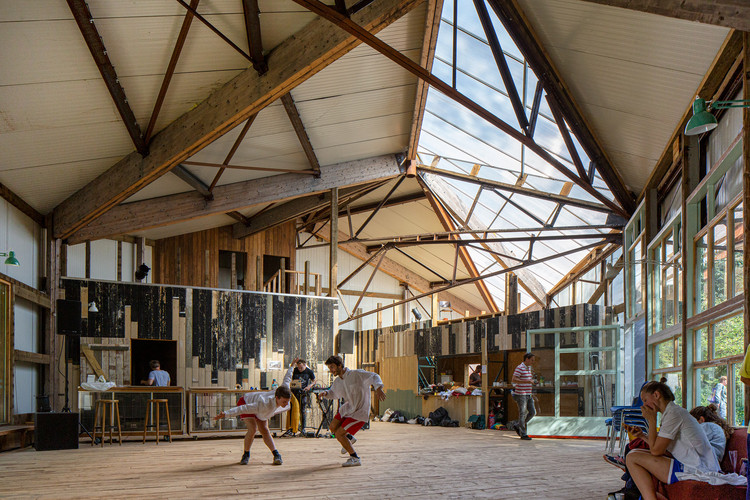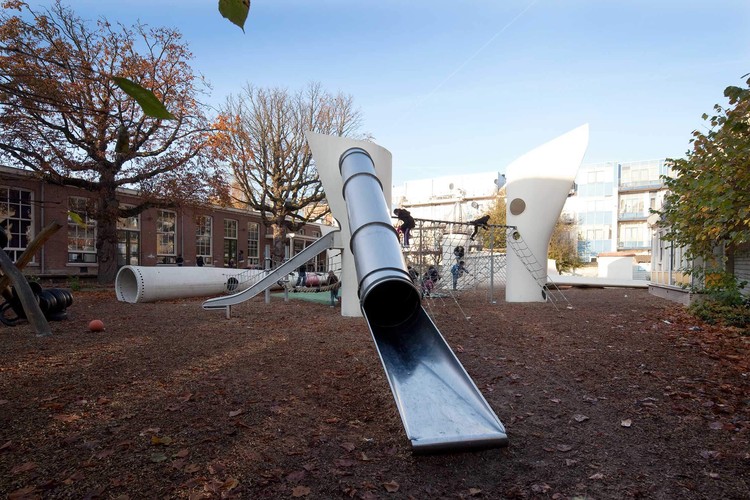
Like natural systems, great architecture is the product of circular processes. For Jan Jongert, a founding partner and architect at Superuse Studios, sustainable design is rooted in a continuous cycle of creation and recreation, use and reuse. Viewing re-use as a circular design strategy, the studio is developing strategies for cities to connect different flows and integrate these systems into the existing urban environment.

For Jan, the latent properties of used materials and products offer added value to new products and buildings. This applies to building materials as well as energy supplies, human resources, water, traffic and food cycles. Superuse Studios distinguishes 14 different flows that enter and exit buildings and urban environments. In an interview with ArchDaily, Jan touches on his design inspirations and background, as well as how the studio is fundamentally rethinking how architects and designers can build in better ways.

Why did you choose to study architecture?
There’s two main drivers behind my choice for architecture. In high school I decided I wanted to work in a profession with a positive impact, but coming from an artistic background, I also needed a strong creative aspect. At that time, I thought architecture was a very interesting combination. What you build needs to be relevant for a long time, and I cannot escape responsibility for what I design and realize. I remember that my interest for architects those days were Konstantin Melnikov and Theo Wijdeveld who became the face of the transition of society in the beginning of the 20th century. Wijdeveld's international exchanges and cross-disciplinary work also intrigued me, in addition to his famous magazine Wendingen.

Can you tell us about how you started Superuse, and how is the studio structured today?
Funny enough Superuse also found its roots in a magazine that we founded as students when studying at the TUDelft in 1990. It was called De Omslag (meaning ‘the turn’ but also ‘the cover’) which gave us a lot of freedom to discover the value of history, theory and social developments for architecture. The open format allowed us to include input from our fellow students and often helped to build support for educational changes after the program in Delft had turned into a very linear - and in our view, narrow minded - approach towards the profession. The magazine had over 40 issues published over 6 years. We already then experimented with reuse of printing paper and environmentally friendly inks, as well as the aluminum printing sheets we used to build our study models.

The frontrunner of Superuse called 2012Architecten was founded in 1997 by two founding members of the magazine: myself and Césare Peeren, and was later joined by Jeroen Bergsma. Our aim was to change the process of design and construction in a way that it would use much less resources and optimally benefit from what a construction site and surroundings have to offer. After 15 years, in 2012 we changed our name to clarify our strategy that we started to call Superuse. Currently our base is in BlueCity at the Maas River bank in Rotterdam, but in 2016 two new studios spawned: Superuse on Site, mainly focused at self sufficient living for housing coops - run by Césare Peeren. Also, Superuse China translating Superuse strategies for a challenging country with potential of real large scale impact, is run from 798 Art district in Beijing by Junyuan Chen.

Your work is rooted in circular design and a rich understanding of materials and adaptive reuse. What can other architects learn from these ideas?
From the very start, one of our aims has been to change the culture of construction. Which means that we had to prove that our approach is technically and financially feasible. One of the outcomes was that we had to test what would happen if we reverse the process of design by limiting our use of materials to what is already available and let the design follow the resources. For over twenty years now we’ve been educating the next generation of architects with this knowledge and developing the tools to make it easier for everyone involved.
From 2004 on, we created several knowledge and exchange platforms ranging from material marketplace (Harvestmap and Pulsapp) and material environmental knowledge (woodguide.org) up to open source collection of knowledge on circular use of resource flows (cyclifier.org). These tools are open to other architects to support them developing their practice in circular construction, and often they hire us to consult them on material use in their projects. But at least as challenging is that we realized we had to overcome cultural barriers against the idea of using waste for architecture. We had to prove that waste can add quality to a design and be beautiful too!

What are some recent projects you’ve been working on?
One of our ongoing projects since five years ago is BlueCity, our base in Rotterdam. It is a 12.500 m2 structure originally built as a tropical swimming paradise. We’re turning it into a paradise for 40 innovative entrepreneurs in the circular economy. It is called BlueCity since we contribute to a special branch of the circular economy called Blue Economy, coined by Gunter Pauli two decades ago, and we intend to run it as a city where waste and resources are exchanged between the different users of the building. Offices, food and product producers, studios and commercial functions contribute heat and Co2 but also the flow of knowledge to enhance each other's development. BlueCity facilitates common facilities like workshops, biolabs, restaurant and conference spaces.

Obviously, all of the reconstruction is materialized with harvested materials from within and around the building. Examples are sections of concrete walls that turned into building blocks, and wooden mooring poles in the river Maas that have been repurposed as desks. We’re also involved in the realization of two housing projects of around 50 apartments. Both are collective housing projects in co-creation with the future dwellers. We see a growing demand for projects since the government accepted a climate law for The Netherlands. These days we’re also developing a new tool to support architects and their development teams when deciding between different types of materials during the design phase.

With changes to climate, technology, and construction, how do you think architects and designers will adapt ways of practicing to change the profession?
We believe everyone, and especially architects, will have to become so much more resourceful than we have been in the past 150 years. We cannot permit ourselves to simply limit our task to delivering a ‘grand design’ but must involve production, climate, program and finance into the design. We must also feel responsible for all the chain of materials and processes involved in the design, execution and life of a building. Also, currently we see a big part of innovation tending towards making sustainable promises towards the future, while at Superuse, we try to make sure that nothing gets wasted today and production of new materials is reduced to the bare minimum.
We know we cannot do this by ourselves, which resulted in the launch of a Dutch architecture team: the circular design collective. We decided to team up with five other circular architecture firms, a structural consultant, a software developing firm and New Horizon, a deconstruction firm who bought our Harvestmap platform last year. Our aim is to share the tools and innovations we’ve been developing in the past years on projects and scale them to support industrialized and repetitive circular construction. We are sure our collective effort is going to speed up the change of the profession much faster.

Changes due to COVID-19 have been swift. How do you think the pandemic will shape design?
I'm not sure it will have a direct effect on the appearance of future buildings but for sure it will have an effect on programming them. On the one hand, we understand that less office space is needed the way we use them now. This will probably lead to transformation of office to housing for instance, this will hopefully contribute to the prevention of sprawl and empty buildings. On the other hand, Covid makes us aware that we’ve become too dependent on a globally distributed chain of production based on cost efficiency like cheap resources and labor. I foresee that on a regional level, it will become more self-sufficient and stimulate innovative local use of resources. I hope for environments where consumption, production and innovation are closely related to each other. Just like we're trying out in BlueCity.

As you look to the future, are there any ideas you think should be front and center in the minds of architects and designers?
After 20 years of practice, it has become very clear to us that governments aiming for a circular economy will also need to change their own business models. We continuously find our clients and ourselves paying for the low cost wasteful production that traditional industry is providing. Especially the high cost of labor and the low cost of virgin materials makes it hard and unfair to compete. Since high taxes on labor and low ones on the use of resources have been common for the past 100 years, it has supported the externalization of environmental costs and the global distribution of low quality and unfair paid production processes. In todays tax regime, architects are forced to design around this huge obstacle forcing us to make many illogical decisions and budgeting revisions. So we will support anyone in Europe to activate the movement like we did. In the Netherlands, we're starting a petition with now over 450 subscribers from the construction industry to support the necessary tax shift.
This article is part of the ArchDaily Topic: Green. Every month we explore a topic in-depth through articles, interviews, news, and projects. Learn more about our monthly topics. As always, at ArchDaily we welcome the contributions of our readers; if you want to submit an article or project, contact us.
























